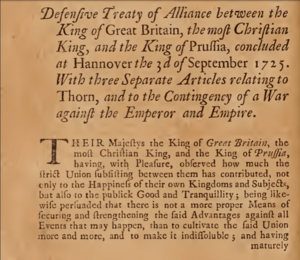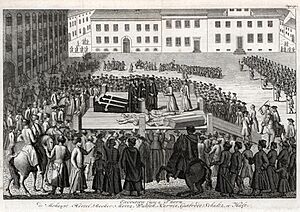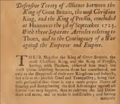Treaty of Hanover (1725) facts for kids
| Defensive Treaty of Alliance between the King of Great Britain, the most Christian King, and the King of Prussia, concluded at Hannover the 3rd of September 1725. | |
|---|---|
 |
|
| Type | Defensive Alliance |
| Context | Stately Quadrille |
| Signed | 3 September 1725 |
| Location | Hannover, Germany |
| Effective | 30 September 1725 |
| Signatories |
List
|
| Ratifiers | |
| Language | French |
The Treaty of Hanover was an important agreement signed on September 3, 1725. It was a defensive alliance between four powerful groups: Great Britain, the Electorate of Hanover (which was ruled by the British King), the Kingdom of France, and the Kingdom of Prussia.
This alliance was created to stand against another powerful group. This other group was an alliance between Austria and Spain, which had formed earlier in May 1725. The Treaty of Hanover aimed to balance the power in Europe.
Later, other countries joined the Hanoverian Alliance. The United Provinces (modern-day Netherlands) joined in 1726, and the Kingdom of Sweden joined in 1727. The Kingdom of Denmark-Norway also signed a separate agreement with Great Britain and France in 1727. However, Prussia later changed sides in 1728, joining the Austrian and Spanish alliance.
Contents
Why was the Hanoverian Alliance formed?
A New Balance of Power in Europe
For a long time, Spain and Austria were close allies. This was because the same royal family, the Habsburgs, ruled both countries. But in 1700, the last Habsburg king of Spain died without children. He chose a French prince, Philip de Bourbon, as his successor.
This led to a big war called the War of the Spanish Succession (1700-1714). This war ended the long alliance between Spain and Austria.
The Return of the Austro-Spanish Alliance
After another war, the War of the Quadruple Alliance (1717-1720), Austria and Spain decided to become allies again. They wanted to restore their power in Europe. At this time, France had become very strong.
King George I of Great Britain was worried about Spain and Austria becoming too powerful together again. He feared they might try to control Europe.
So, the Treaty of Hanover was signed to create a strong group that could stand up to this new Austro-Spanish alliance. This new alliance would later include the Russian Empire, and the regions of Bavaria and Cologne.
Promises of Support
The countries that signed the Treaty of Hanover made important promises to each other. They agreed to be true friends and strong allies forever. They also promised to help each other if any country was attacked.
The treaty stated that they would work together to "prevent and repel all Wrongs and Damages." This meant they would use the best ways they could find to protect each other.
Military Help for Allies
The treaty also laid out how much military help each country would provide. If an enemy declared war, the allies would send troops and cavalry right away.
- Great Britain and France each promised to send 8,000 troops and 4,000 cavalry.
- Prussia, a smaller country at the time, would send 3,000 troops and 2,000 cavalry.
Naval support (ships and sailors) was also guaranteed if needed to protect their allies.
What happened in the City of Thorn?
A Religious Conflict
In 1714, a serious event happened in a city called Thorn (now Toruń, Poland). This event was a religious conflict. For many years, there had been tension between Catholics and Lutherans in Thorn. This was because Poland-Lithuania had accepted the Counter-Reformation, which was a movement to strengthen the Catholic Church.
In 1660, a treaty called the Treaty of Oliva had promised religious tolerance in the area. By then, the city of Thorn was about half Catholic and half Lutheran.
The Tumult of Thorn
On March 16 and 17, 1726, a big problem occurred during a Catholic celebration. Some Catholic students complained that Lutherans watching the parade did not show respect. Fights broke out between the two groups.
A Catholic monastery was damaged. Catholic religious items were destroyed, and part of the altar was harmed. Lutherans also burned Catholic books and paintings outside the monastery.

After these events, the Catholic Church sued the city in Poland's highest court. The court, led by King Augustus II, decided that thirteen Lutherans should be executed.
International Concern
Great Britain and Prussia were very worried about these executions. Both countries had promised to uphold the Treaty of Oliva, which guaranteed religious tolerance. They believed that Poland's actions showed a lack of tolerance towards its Lutheran citizens.
This event damaged Poland's reputation around the world. Great Britain and Prussia agreed to work together to pressure Poland to enforce religious tolerance in Thorn and other areas.
Images for kids
See also
 In Spanish: Tratado de Hannover para niños
In Spanish: Tratado de Hannover para niños



